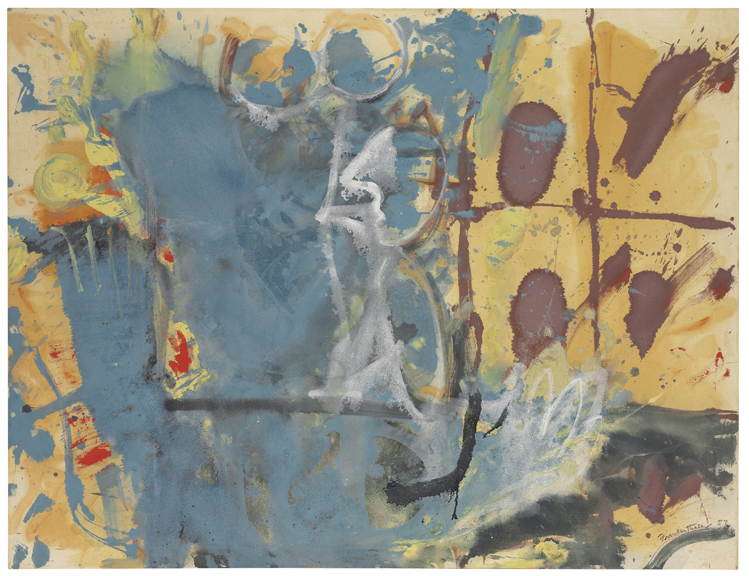Helen Frankenthaler: Paintings
Sep 26 — Nov 9, 2019
Berggruen Gallery is proud to present Helen Frankenthaler: Paintings, an exhibition of paintings from 1953–1978 by one of the preeminent artists of her time, Helen Frankenthaler (1928–2011). This presentation continues a history of exhibiting Frankenthaler’s work on the West Coast, dating back to her first Bay Area show at John Berggruen Gallery in 1972. Helen Frankenthaler: Paintings will be on view September 26 through November 9, 2019. The gallery will host an opening reception on Thursday, September 26 from 5:00 to 7:00pm.
Spanning three decades of Frankenthaler’s career, this exhibition includes some of the artist’s most significant and evocative paintings, highlighting the evolution of her artistic practice in the ways she translated the world around her. The artist did not follow stringent rules of painting, but instead employed a pioneering soak-stain technique that ultimately created new parameters and possibilities. Frankenthaler invented this method of painting by pouring and brushing heavily diluted paint onto unstretched, unprimed canvas. The distinctive process creates ethereal pools of floating color. The effect is almost translucent, more closely resembling watercolor than her actual mediums of oil or acrylic. Soak-staining acknowledges the very flatness of the canvas itself, yet it also produces the illusion of depth and space.
Frankenthaler’s paintings are emphatically non-representational, yet her work is often rooted in an evocation of landscape. While certain works in the exhibition render the raw and unparalleled beauty of earthly forms, others simply reveal atmospheres of color that seem to serendipitously dance across the canvas. The exhibition demonstrates this exquisite complexity, revealing the interplay of control and spontaneity. The paintings are grounded yet otherworldly, flat yet spacious, restrained yet playful, subtle yet sublime.
Helen Frankenthaler: Paintings features nineteen paintings by the artist, including rarely exhibited works from private collections, as well as a woodcut, Madame Butterfly, from 2000. Among the early works in the exhibition are Granada (1953) and Hommage à Chardin (1957), both masterful examples of Frankenthaler’s soak-stain technique. Progressing into the late sixties, Coalition (1968) exemplifies the unique strengths of Frankenthaler’s painting from that decade. American art historian Barbara Rose describes Coalition as one of the “finest paintings produced anywhere in the late sixties.”1 The exhibition concludes with work from the seventies, including Moveable Blue (1973), a large, panoramic painting that is distinguished by its impressive size and alluring rendition of the natural world. Art historian and scholar Douglas Dreishpoon calls the painting a “magisterial statement of place reimagined,” revealing how Frankenthaler “pushed the limits of staining to a staggering degree.”2
The present exhibition is the result of a wonderful, long-lasting relationship between Helen Frankenthaler and Berggruen Gallery, which endured for several decades. The artist’s last solo exhibition with the gallery occurred in 2010. Gretchen and John Berggruen then wrote, “what began in 1972 as an adventure for us, and a leap of faith for Helen, evolved into a warm and enduring friendship.” Berggruen Gallery is honored to present another important exhibition of her paintings.
Helen Frankenthaler was born December 12, 1928 in New York City. She first studied Painting under acclaimed Mexican muralist, Rufino Tamayo, at the Dalton School. In 1949 she graduated from Bennington College where she studied with Paul Feeley, following which she briefly studied with German-American painter Hans Hofmann. Frankenthaler presented her first solo exhibition in 1951 at Tibor de Nagy Gallery, New York and in 1960 had her first museum retrospective at the Jewish Museum, New York. In 1969 the Whitney Museum of American Art presented a major retrospective of her work that traveled to museums in the United Kingdom and Germany. Frankenthaler was one of few female artists to create a successful career in an overwhelmingly male-dominated era, and her revolutionary practices propelled the transition from Abstract Expressionism to Color Field painting. She is celebrated as one of the most innovative and influential painters of the 20th century.
Frankenthaler’s work is represented in significant museum collections in the United States, including the Whitney Museum of American Art, New York; The Smithsonian American Art Museum, Washington, D.C.; The National Gallery of Art, Washington, D.C.; The Museum of Modern Art, New York; The Museum of Fine Arts, Boston; The Metropolitan Museum of Art, New York; the Los Angeles County Museum of Art; and the San Francisco Museum of Modern Art. Her work is also included in major international public collections, such as the Art Gallery of Ontario, Toronto, the Musée National d’Art Moderne, Centre Georges Pompidou, Paris; and the National Gallery of Australia, Canberra. Helen Frankenthaler won first prize at the Premiere Biennale de Paris in 1959, and in 1966 she represented the United States in the 33rd Venice Biennale, alongside Ellsworth Kelly, Roy Lichtenstein, and Jules Olitski. She was the recipient of numerous honors and awards, including the 2001 National Medal of Arts, and was appointed the 2011 Honorary Academician of the Royal Academy of Arts. She died December 27, 2011 in Darien, Connecticut.
Helen Frankenthaler: Paintings, September 26 – November 9, 2019. On view at 10 Hawthorne Street, San Francisco, CA 94105. Images and preview are available upon request. For all inquiries, please contact the gallery by phone (415) 781-4629 or by email info@berggruen.com.
1 Barbara Rose, Frankenthaler (New York, New York, Henry N. Abrams, 1972): 98.
2 Douglas Dreishpoon, Giving Up One’s Mark, (Buffalo, New York, Albright-Knox Art Gallery): 17.
Check gallery website for hours and additional info
